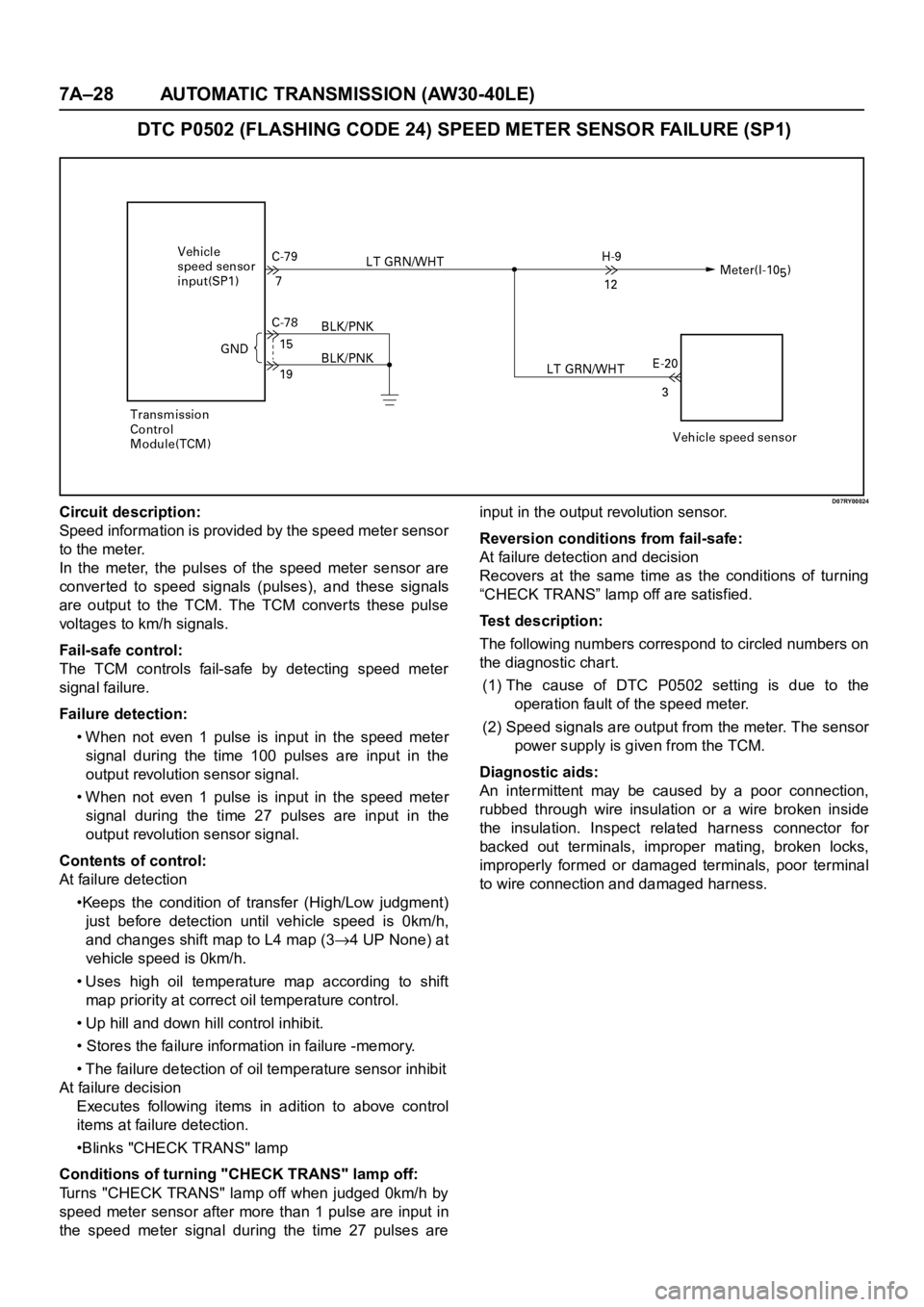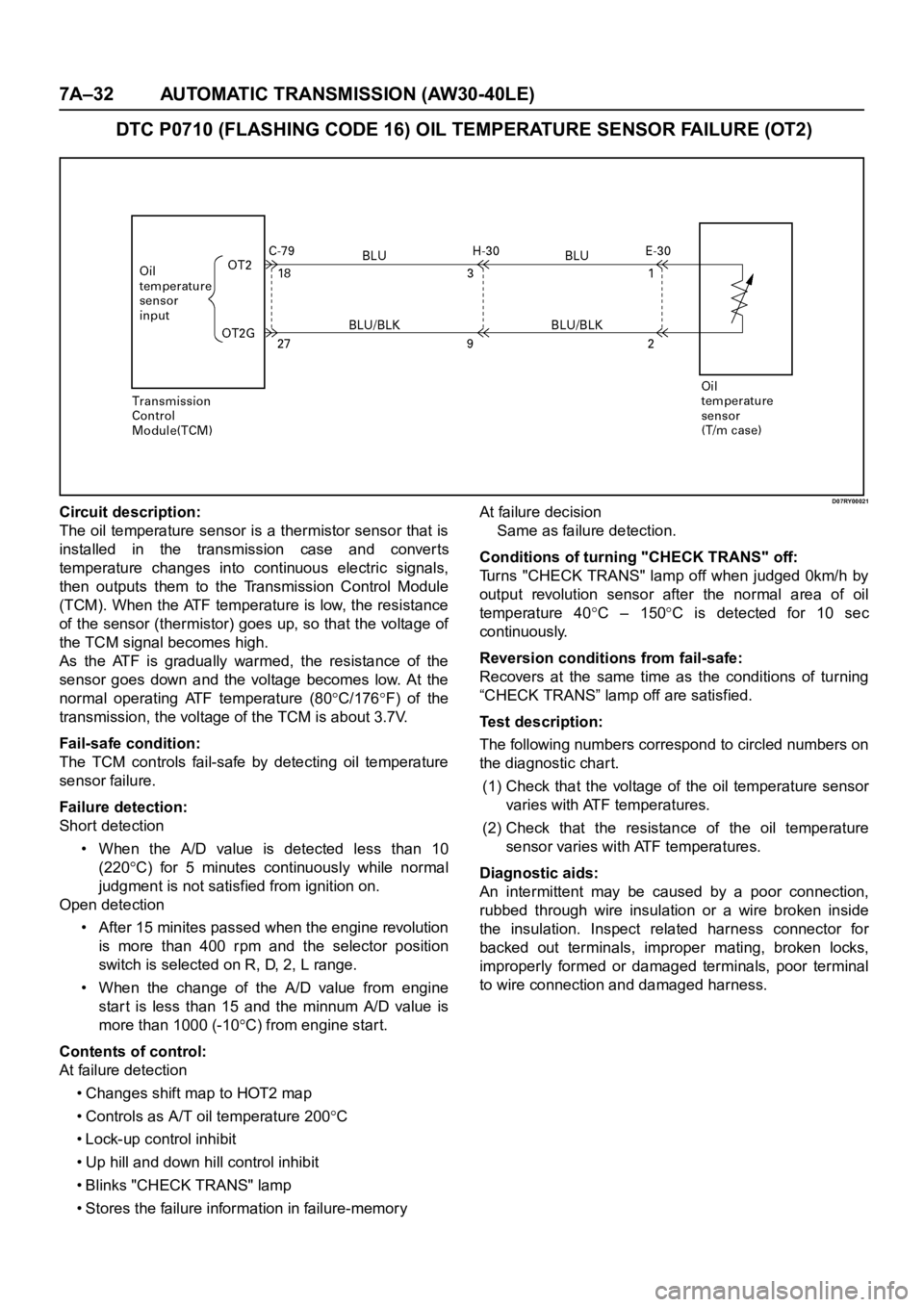1998 OPEL FRONTERA lock
[x] Cancel search: lockPage 5793 of 6000

7A–12 AUTOMATIC TRANSMISSION (AW30-40LE)
OVERDRIVE AND LOCK-UP OPERATING CONDITIONS
The overdrive and lock-up clutch operate if the following conditions are satisfied.
(1*):
If transmission oil temperature is more than 130C, lock-up is inhibit.
OverdriveLock-up clutch
Transmission shift positionD range (1*)
O/D OFF switchOFF (O/D OFF lamp OFF)—
Stop lamp switch—OFF
Throttle opening—Except fully closed
Vehicle speedAbout 49 km/h or more3rd: About 50 km/h or more
O/D: About 65 km/h or more
Page 5802 of 6000

AUTOMATIC TRANSMISSION (AW30-40LE) 7A–21
TRANSMISSION DATA
Item Unit Enigne running at idle
Current Gear1
Lock Up Inactive, Active Inactive
Selector PositionPar k
AT Output Speed (Automatic Transmission) RPM 0 RPM
Output Speed (Meter Signal Side) RPM 0 RPM
AT Input Speed (Automatic Transmission) RPM 0 RPM
Engine Speed RPM 695
745 RPM
Vehicle Speed (Output Side) km/h 0 km/h
Throttle Position % 0 %
Throttle Position Sensor V 0.25
0.45V
AT Oil Temperature (Automatic Transmission)
C, F70 80C (158 176F)
Shift Pattern
Desired PCS Pressure (Pressure Control Solenoid) kPa
PCS Desired Current (Pressure Control Solenoid) mA
PCS Actual Current (Pressure Control Solenoid) mA
Overdrive Off Switch Off, On
Brake Switch Open 0V, Closed 12V Closed 12V
Winter Switch Open, Closed 0V Open
Power Switch Open, Closed 0V Open
Diagnostic Request Open, Closed Open
Winter Lamp Inactive 12V, Active 0V Inactive 12V
Power Lamp Inactive 12V, Active 0V Inactive 12V
Check Light Inactive 12V, Active 0V Inactive 12V
AT Oil Temperature Lamp (Automatic Transmission) Inactive 12V, Active 0V Inactive 12V
Solenoid 2-3 Inactive 0V, Active 12V Inactive 0V
Solenoid 1-2/3-4 Inactive 0V, Active 12V Active 12V
TCC Solenoid (Torque Conver ter Clutch) Inactive 0V, Active 12V Inactive 0V
Page 5803 of 6000

7A–22 AUTOMATIC TRANSMISSION (AW30-40LE)
TCC DATA
Item Unit Enigne running at idle
Current Gear1
Lock Up Inactive, Active Inactive
AT Output Speed (Automatic Transmission) RPM 0 RPM
Output Speed (Meter Signal Side) RPM 0 RPM
AT Input Speed (Automatic Transmission) RPM 0 RPM
Engine Speed RPM 695
745 RPM
Vehicle Speed (Output Side) km/h 0 km/h
Throttle Position % 0 %
Gear Ratio :1 2.804
AT Oil Temperature (Automatic Transmission)
C, F 70 80C (158 176F)
TCC Slip Speed RPM 695
745 RPM
TCC Solenoid Pressure Desired kPa 0 kPa
Desired TCC Solenoid Current mA 0 mA
Actual TCC Solenoid Current mA 0 mA
Page 5806 of 6000

AUTOMATIC TRANSMISSION (AW30-40LE) 7A–25
DIAGNOSTIC TROUBLE CODES (DTC) CHECK
DTC
NUMBERFLASHING
CODEDESCRIPTION
P0120 21 ANALOG THROTTLE SIGNAL FAILURE (VTH)
P0502 24 SPEED METER SENSOR FAILURE (SP1)
P0705 17 GEAR SELECTOR FAILURE (PRND2L)
P0710 16 OIL TEMPERATURE SENSOR FAILURE (OT2)
P0717 14 INPUT REVOLUTION SENSOR FAILURE (NC0)
P0722 11 OUTPUT REVOLUTION SENSOR FAILURE (SP2)
P0727 13 ENGINE REVOLUTION SIGNAL FAILURE (NE)
P0743 33 TORQUE CONVERTER CLUTCH CONTROL LOCK-UP (ON/OFF) SOLENOID
FA I L U R E ( S L )
P0748 35 PRESSURE CONTROL SOLENOID FAILURE (STH)
P0753 31 SOLENOID 1 FAILURE (S1)
P0758 32 SOLENOID 2 FAILURE (S2)
P1121 23 ANALOG THROTTLE SIGNAL FAILURE (VREF, VGND)
Page 5807 of 6000

7A–26 AUTOMATIC TRANSMISSION (AW30-40LE)
DTC P0120 (FLASHING CODE 21) ANALOG THROTTLE SIGNAL FAILURE (VTH)
D07RY00023Circuit description:
When the signal of the engine throttle position sensor
located on the accelerator pedal is supplied to the TCM,
the TCM judges the opening condition of the throttle.
The shift point of the transmission is determined by this
opening condition of the throttle.
Fail-safe control:
The TCM controls fail-safe by detecting analog throttle
signal (VTH) failure.
Failure detection:
•When the throttle input voltage is detected less than
0.112V or more than 4.417V for 2.0 seconds.
Contents of control:
At failure detection
•Throttle opening for line pressure control ... Throttle
opening 100%
•Throttle opening for shift control ... Throttle opening
0%
•Lock-up control inhibit
•Up hill and down hill control inhibit
•Squat control inhibit
At failure decision
Executes following items in addition to above control
items at failure detection.
•Blinks "CHECK TRANS" lamp
•Stores the failure information in failure-memory
Conditions of turning "CHECK TRANS" lamp off:
Turns “CHECK TRANS” lamp off when judged 0km/h by
output revolution sensor after throttle signal input voltage
is detected more than 0.112V and less than 4.717V.
(however, uses 0 km/h judgment by back-up vehicle
speed at output revolution failure)Reversion conditions from fail-safe:
At failure detection
Immediately recovers when the throttle input voltage
is detected more than 0.112V and less than 4.717V.
At failure decision
Recovers at the same time as the conditions of
turning “CHECK TRANS” lamp off are satisfied.
Test description:
The following numbers correspond to circled numbers on
the diagnostic char t.
(1) Check that the throttle input voltage is 0.25 to 0.45V.
(2)At this test, check that as the throttle opens, the
voltage goes up and that the voltage reaches 3.74 to
4.56V at the full open status.
(3) Check the power supply voltage (4.75 – 5.25V) of the
throttle position sensor.
Diagnostic aids:
An intermittent may be caused by a poor connection,
rubbed through wire insulation or a wire broken inside
the insulation. Inspect related harness connector for
backed out terminals, improper mating, broken locks,
improperly formed or damaged terminals, poor terminal
to wire connection and damaged harness.
Page 5809 of 6000

7A–28 AUTOMATIC TRANSMISSION (AW30-40LE)
DTC P0502 (FLASHING CODE 24) SPEED METER SENSOR FAILURE (SP1)
D07RY00024Circuit description:
Speed information is provided by the speed meter sensor
to the meter.
In the meter, the pulses of the speed meter sensor are
converted to speed signals (pulses), and these signals
are output to the TCM. The TCM converts these pulse
voltages to km/h signals.
Fail-safe control:
The TCM controls fail-safe by detecting speed meter
signal failure.
Failure detection:
• When not even 1 pulse is input in the speed meter
signal during the time 100 pulses are input in the
output revolution sensor signal.
• When not even 1 pulse is input in the speed meter
signal during the time 27 pulses are input in the
output revolution sensor signal.
Contents of control:
At failure detection
•Keeps the condition of transfer (High/Low judgment)
just before detection until vehicle speed is 0km/h,
and changes shift map to L4 map (3
4 UP None) at
vehicle speed is 0km/h.
•Uses high oil temperature map according to shift
map priority at correct oil temperature control.
• Up hill and down hill control inhibit.
• Stores the failure information in failure -memory.
• The failure detection of oil temperature sensor inhibit
At failure decision
Executes following items in adition to above control
items at failure detection.
•Blinks "CHECK TRANS" lamp
Conditions of turning "CHECK TRANS" lamp off:
Turns "CHECK TRANS" lamp off when judged 0km/h by
speed meter sensor after more than 1 pulse are input in
the speed meter signal during the time 27 pulses areinput in the output revolution sensor.
Reversion conditions from fail-safe:
At failure detection and decision
Recovers at the same time as the conditions of turning
“CHECK TRANS” lamp off are satisfied.
Test description:
The following numbers correspond to circled numbers on
the diagnostic char t.
(1) The cause of DTC P0502 setting is due to the
operation fault of the speed meter.
(2) Speed signals are output from the meter. The sensor
power supply is given from the TCM.
Diagnostic aids:
An intermittent may be caused by a poor connection,
rubbed through wire insulation or a wire broken inside
the insulation. Inspect related harness connector for
backed out terminals, improper mating, broken locks,
improperly formed or damaged terminals, poor terminal
to wire connection and damaged harness.
Page 5811 of 6000

7A–30 AUTOMATIC TRANSMISSION (AW30-40LE)
DTC P0705 (FLASHING CODE 17) GEAR SELECTOR FAILURE (PRND2L)
D07RY00022Circuit description:
The neutral start switch gives the signals related to the
selector lever position (PRND2L) to the Transmission
Control Module (TCM). The neutral star t switch turns on
when the select lever is shifted to the P, R, N, D, 2 or L
range. The neutral star t switch, which is connected to the
starter switch circuit, is available only when the select
lever is in the P or N range
The neutral start switch is connected to the transmission
manual shaft and installed in the transmission case.
Fail-safe condition:
The TCM controls fail-safe by detecting selector position
switch fail ure.
Failure detection:
(1) OPEN:
• When all switches are OFF
• When the failure criteria continues for 30 seconds
if the vehicle speed which is calculated by output
revolution sensor is more than 30 km/h and the
engine revolution is more than 1500 rpm.
(2) SHORT:
• When more than two switches are ON at the same
time.
• When the failure criteria condition for 10 seconds.
Contents of control:
At failure detection
(1) OPEN: D range judgment
(2) SHORT: Judged by priority D>2>L>R>N>P
•Up hill and down hill control inhibit
•Winter mode inhibitAt failure decision
Excutes following items in addition to above control
items at failure detection.
•Blinks "CHECK TRANS" lamp
•Stores the failure information in failure-memory
•Reverse lockout control inhibit
Conditions of turning “CHECK TRANS” off:
Turns “CHECK TRANS” lamp off when only one of all
switches is ON.
Reversion conditions from fail-safe:
Turns “CHECK TRANS” lamp off when only one of all
switches is ON.
Test description:
The following numbers correspond to circled numbers on
the diagnostic char t.
(1) It is judged whether the input signal received from
the neutral star t switch by the TCM is proper or not.
(2)The power status of the neutral start switch is
checked.
(3) The continuity between neutral star t switch terminals
and the continuity of the wire connected to the
neutral start switch are checked.
Diagnostic aids:
An intermittent may be caused by a poor connection,
rubbed through wire insulation or a wire broken inside
the insulation. Inspect related harness connector for
backed out terminals, improper mating, broken locks,
improperly formed or damaged terminals, poor terminal
to wire connection and damaged harness.
Page 5813 of 6000

7A–32 AUTOMATIC TRANSMISSION (AW30-40LE)
DTC P0710 (FLASHING CODE 16) OIL TEMPERATURE SENSOR FAILURE (OT2)
D07RY00021Circuit description:
The oil temperature sensor is a thermistor sensor that is
installed in the transmission case and converts
temperature changes into continuous electric signals,
then outputs them to the Transmission Control Module
(TCM). When the ATF temperature is low, the resistance
of the sensor (thermistor) goes up, so that the voltage of
the TCM signal becomes high.
As the ATF is gradually warmed, the resistance of the
sensor goes down and the voltage becomes low. At the
normal operating ATF temperature (80
C/176F) of the
transmission, the voltage of the TCM is about 3.7V.
Fail-safe condition:
The TCM controls fail-safe by detecting oil temperature
sensor failure.
Failure detection:
Short detection
• When the A/D value is detected less than 10
(220
C) for 5 minutes continuously while normal
judgment is not satisfied from ignition on.
Open detection
• After 15 minites passed when the engine revolution
is more than 400 rpm and the selector position
switch is selected on R, D, 2, L range.
• When the change of the A/D value from engine
star t is less than 15 and the minnum A/D value is
more than 1000 (-10
C) from engine star t.
Contents of control:
At failure detection
• Changes shift map to HOT2 map
• Controls as A/T oil temperature 200
C
• Lock-up control inhibit
• Up hill and down hill control inhibit
• Blinks "CHECK TRANS" lamp
• Stores the failure information in failure-memoryAt failure decision
Same as failure detection.
Conditions of turning "CHECK TRANS" off:
Turns "CHECK TRANS" lamp off when judged 0km/h by
output revolution sensor after the normal area of oil
temperature 40
C – 150C is detected for 10 sec
continuously.
Reversion conditions from fail-safe:
Recovers at the same time as the conditions of turning
“CHECK TRANS” lamp off are satisfied.
Test description:
The following numbers correspond to circled numbers on
the diagnostic char t.
(1) Check that the voltage of the oil temperature sensor
varies with ATF temperatures.
(2) Check that the resistance of the oil temperature
sensor varies with ATF temperatures.
Diagnostic aids:
An intermittent may be caused by a poor connection,
rubbed through wire insulation or a wire broken inside
the insulation. Inspect related harness connector for
backed out terminals, improper mating, broken locks,
improperly formed or damaged terminals, poor terminal
to wire connection and damaged harness.